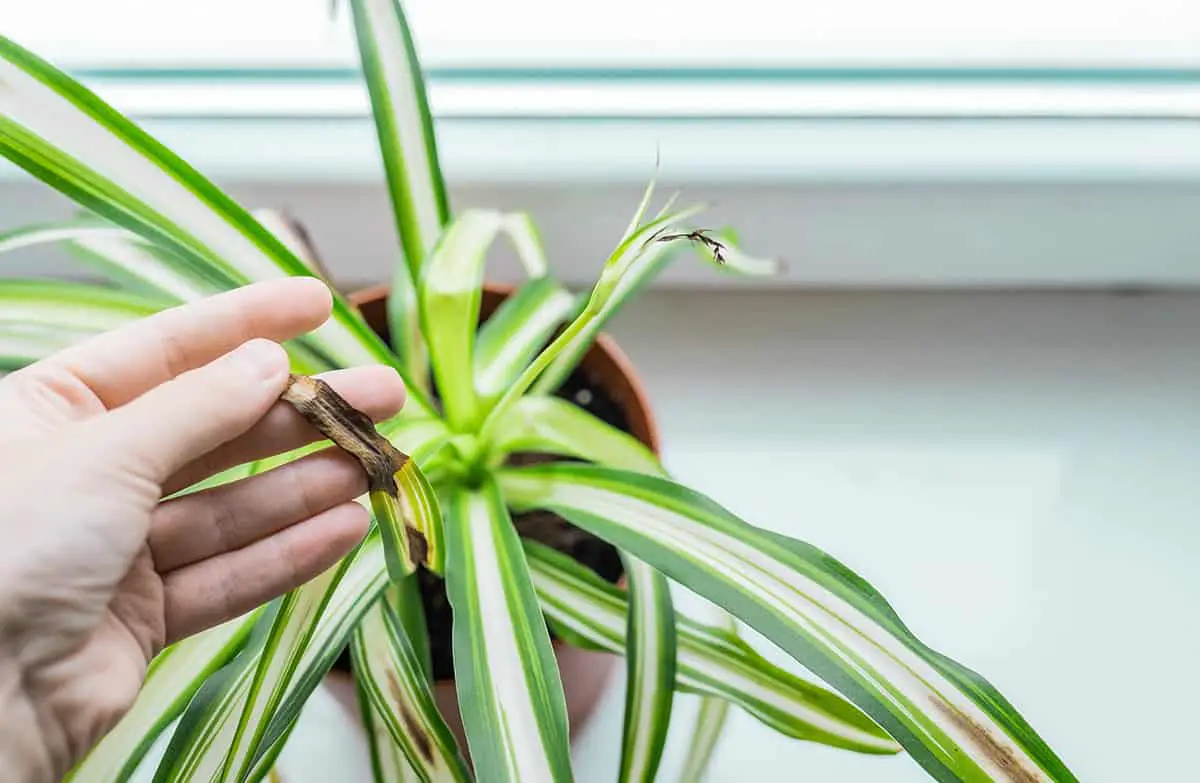You’ve noticed your once-lush spider plant looking droopy and lifeless, its leaves turning brown at the tips. Despite your efforts, it seems to be struggling. Reviving a wilting spider plant is possible with the right approach. Here are the steps to restore your spider plant’s health, from identifying the cause of its distress to implementing effective remedies.
Table of Contents
Identifying Signs of Wilting In Your Spider Plants
When a spider plant wilts, it shows several clear signs. The most obvious is drooping leaves. Healthy leaves are firm and upright. Wilting leaves are floppy.
Yellowing is another sign. Leaves might turn yellow or brown. This color change often begins at the tips and edges.
Dry soil can cause your spider plant to wilt. Check the soil’s moisture. If the soil feels dry, your plant may need water. Watch for brown leaf tips, which is a sign of low humidity.
Overwatering can also make leaves wilt. Soggy soil can lead to root rot. Look for signs of dampness. Root rot can cause wilt and yellowing leaves.
Pest infestation might be a problem as well. Scales and mealybugs are common pests. They can weaken the plant and cause wilting.
Common Wilting Signs and their causes:
| Sign | Cause |
|---|---|
| Drooping leaves | Lack of water |
| Yellow/brown tips | Low humidity, dry soil |
| Soggy soil | Overwatering, root rot |
| Pest damage | Scales, mealybugs |
Immediate Care for Wilting Spider Plants

To revive a wilting spider plant, focus on correct watering techniques, adjusting light exposure, and assessing soil conditions.
Watering
Start with checking the moisture level of the soil. Spider plants need the soil to dry slightly between waterings. Overwatering can cause root rot. Underwatering will dry out the plant, leading to wilting. Use a watering schedule that allows the soil to dry out slightly between waterings. Ensure good drainage to prevent standing water.
Use filtered or distilled water if possible. Tap water can have chemicals like chlorine and fluoride that build up and damage the plant. Pour water until it drains from the bottom of the pot, ensuring all the roots are reached. Morning watering is best to allow any excess moisture to evaporate.
Adjusting Light Exposure
Spider plants need bright, indirect sunlight. Direct sunlight can scorch the leaves, leading to browning and wilting. Place your plant near a window with filtered light or in a well-lit room away from direct sunbeams. If the light is too low, growth slows, and leaves might become yellow.
Artificial lights, like fluorescent bulbs, can supplement natural light. Spider plants adapt well to these. Ensure the plant is not near a cold window or draft, as cold air can stress the plant and cause wilting. Maintain consistent, moderate temperatures.
Assessing Soil Condition
Check the soil for compaction, which can restrict root growth and water absorption. Use your finger to feel the top couple of inches. If it’s hard and dense, it might be time to repot. Spider plants thrive in well-draining, general-purpose potting soil. Avoid heavy clay soils.
Repotting every couple of years helps refresh the soil. Look for signs of pests like scales or mealybugs. These can cause wilting. Treat infestations promptly with insecticidal soap or alcohol wipes. Regularly monitor the health of the plant to catch potential issues early.
Prevention of Future Wilting

To avoid future wilting of your spider plant, focus on key environmental factors and adopt routine maintenance habits.
Environmental Factors
Spider plants thrive in bright, indirect sunlight. Place your plant near a window with filtered light. Avoid direct sunlight, as it can scorch the leaves. Ensure your plant is in a room with a stable temperature. Spider plants prefer temperatures between 55°F and 80°F.
Humidity levels are also important. Spider plants do well in moderate humidity. Mist your plant regularly if the air is dry. Avoid placing the plant near air vents or heaters, which can dry out the leaves. Proper ventilation prevents mold and pest infestations.
Routine Maintenance Tips
Water your spider plant when the top inch of soil feels dry. Over-watering can cause root rot, while under-watering leads to wilting. Use room temperature water to avoid shocking the plant’s roots. Ensure the pot has drainage holes to prevent water from accumulating at the bottom.
Fertilize your spider plant monthly during the growing season with a balanced liquid fertilizer. Trim any brown tips from the leaves to keep the plant looking healthy. Repotting every couple of years ensures that the roots have enough space to grow. Check for pests like spider mites and aphids, and treat them promptly.






